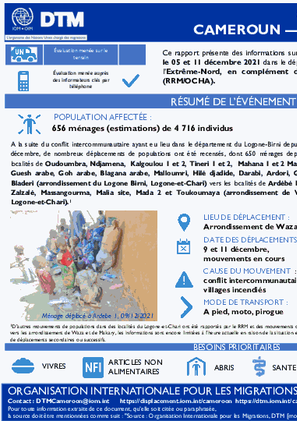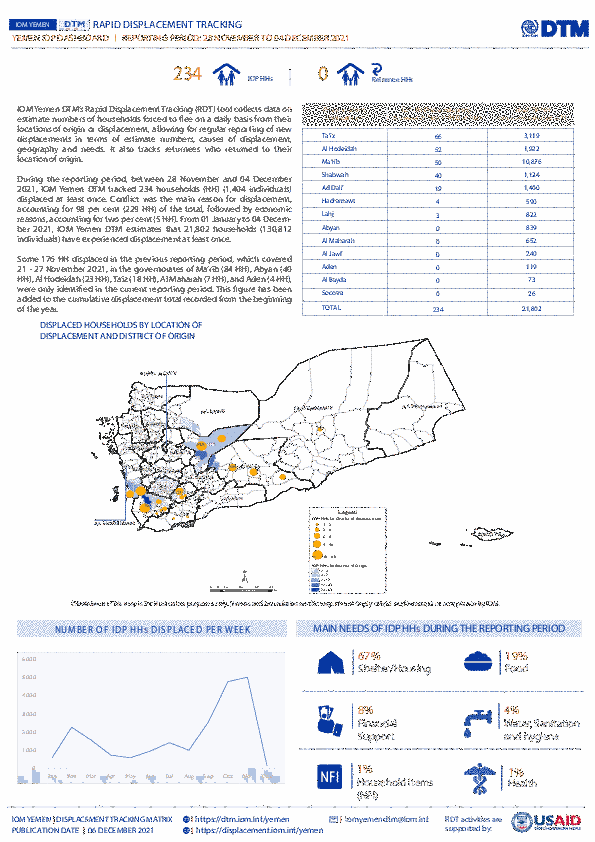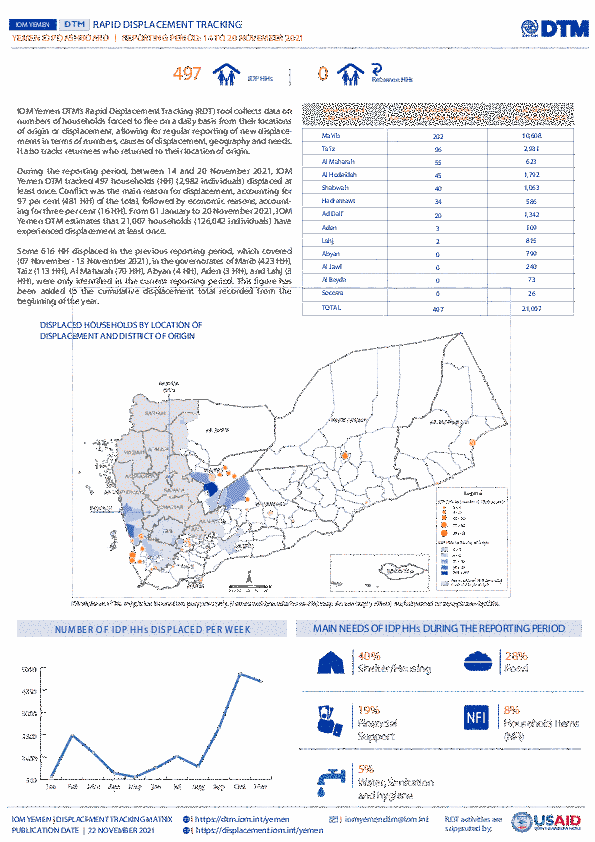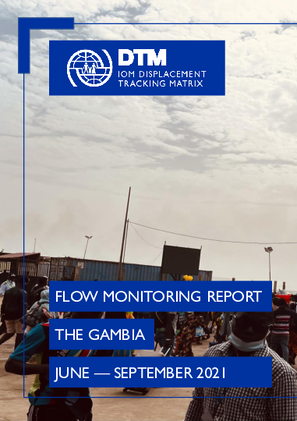-
Countries
-
Data and Analysis
-
Special Focus
-
Crisis Responses

Contact
DTM Cameroon, DTMCameroun@iom.int
Language
French
Location
Cameroon
Period Covered
Dec 05 2021
Dec 11 2021
Activity
- Event Tracking
- Mobility Tracking
Ce rapport présente des informations sur le mouvements de populations enregistre entre le 05 et 11 décembre 2021 dans le département du Logone-Et-Chari de la région de l’Extrême-Nord, en complément des alertes d’autres acteurs humanitaires (RRM/OCHA). A la suite du conflit intercommunautaire ayant eu lieu dans le département du Logone-Birni depuis le 5 décembre, de nombreux déplacements de populations ont été recensés, dont 650 ménages depuis les localités de Oudoumbra, Ndjamena, Kalgoulou 1 et 2, Tineri 1 et 2, Mahana 1 et 2 Mardiya, Guesh arabe, Goh arabe, Blagana arabe, Malloumri, Hilé djadide, Darabi, Ardori, Galam Bladeri (arrondissement du Logone Birni, Logone-et-Chari) vers les localités de Ardébé 1 et 2, Zalzalé, Massangourma, Malia site, Mada 2 et Toukoumaya (arrondissement de Waza, Logone-et-Chari).

Contact
DTM Nigeria, AllUsersInDTMNigeria@iom.int
Language
English
Location
Nigeria
Period Covered
Dec 04 2021
Dec 10 2021
Activity
- Mobility Tracking
- Baseline Assessment
- Points of Entry (PoE)
During the COVID-19 pandemic, IOM's Displacement Tracking Matrix (DTM), in collaboration with the World Health Organization (WHO), monitors the movements to and from Nigeria's Adamawa and Borno States in North-East Nigeria. Assessments are conducted at Points of Entry located along the border with Cameroon.
During the period 04 - 10 December 2021, 192 movements were observed at three Points of Entry in Borno state. Of the total movements recorded, 151 were incoming from the Far North Region in Cameroon while 41 outgoing movements were recorded from Borno State to the Far North Region in Cameroon.

Contact
DTM Nigeria, AllUsersInDTMNigeria@iom.int
Language
English
Location
Nigeria
Period Covered
Dec 06 2021
Dec 12 2021
Activity
- Event Tracking
- Mobility Tracking
Nigeria's North Central and North West Zones are afflicted with a multidimensional crisis that is rooted in long-standing tensions between ethnic and religious groups and involves attacks by criminal groups and banditry/hirabah (such as kidnapping and grand larceny along major highways). The crisis has accelerated during the past years because of the intensification of attacks and
has resulted in widespread displacement across the region.
Between 06 and 12 December 2021, armed clashes between herdsmen and farmers; and bandits and local communities have led to new waves of population displacement. Following these events, rapid assessments were conducted by DTM (Displacement Tracking Matrix) field staff with the purpose of informing the humanitarian community and government partners, and enable targeted response. Flash reports utilise direct observation and a broad network of key informants to gather representative data and collect information on the number, profile and immediate needs of affected populations.

Contact
DTM DRC, iomdrcdtm@iom.int
Language
French
Location
Democratic Republic of the Congo
Period Covered
Nov 25 2021
Nov 26 2021
Activity
- Event Tracking
- Mobility Tracking
Du 13 au 21 novembre 2021, une série d’incursions attribuées aux miliciens CODECO a été rapportée dans les villages de Largu, Ngazba, Nyali, Kiza, Djisso, Djala, Jissa, Duma, Ngbaluba dans le groupement de Buku, chefferie de Bahema Nord, dans le territoire de Djugu et dans deux sites de déplacement, notamment le site Drodo situé dans le village de Duma, et le site de Tche dans le village de Dhessa, tous deux dans le groupement de Lossandrema, chefferie de Bahema Nord. Ces attaques ont causé d’importants dégâts matériels et humains : plusieurs maisons et abris ont été incendiés et détruits et plusieurs personnes déplacées ont été tuées ou blessées. Ces exactions ont obligé environ 80 000 individus à fuir leur village et site de déplacement pour trouver refuge dans le site de déplacement de Rhoe, en groupement Buku, chefferie de Bahema Nord, dans le territoire de Djugu en province d’Ituri. Les villages et site de déplacement qui ont été attaqués sont aujourd’huividés de leur population.

Contact
DTM Sudan; dtmsudan@iom.int
Language
English
Location
Sudan
Snapshot Date
Dec 12 2021
Activity
- Event Tracking
- Mobility Tracking
The DTM Emergency Event Tracking (EET) is deployed to track sudden displacement and population movements, provide more frequent updates on the scale of displacement, and quantify the affected population when needed. As a subcomponent of the new Mobility Tracking methodology in Sudan (Round Two), and activated on a need basis, EET utilises a broad network of key informants to capture best estimates of the affected population presence per location – a useful tool for humanitarian response planning and design.

Contact
DTM Yemen, iomyemendtm@iom.int
Language
English
Location
Yemen
Period Covered
Nov 28 2021
Dec 04 2021
Activity
- Rapid Emergency Registration
- Mobility Tracking
IOM Yemen DTM’s Rapid Displacement Tracking (RDT) tool collects data on numbers of households forced to flee on a daily basis from their locations of origin or displacement, allowing for regular reporting of new displacements in terms of numbers, geography, and needs. It also tracks Returnees who returned to their location of origin.
From 01 January 2021 to 4 December 2021, IOM Yemen DTM estimates that 21,802 households (HH) (130,812 Individuals) have experienced displacement at least once.
Since the beginning of 2021, DTM also identified 3,814 displaced households who left their locations of displacement and either moved back to their place of origin or another location.
Between 28 November and 04 December 2021, IOM Yemen DTM tracked 234 households (1,404 individuals) displaced at least once.The top three districts of the top three governorates that saw the highest number of displacements were:
- Taiz (66 HH) – Mawza (48 HH), Salah (6 HH), As Silw (5 HH) districts. Most displacements in the governorate were internal.
- Al Hodeidah (52 HH) – Hays (39 HH), Al Khukhah (13 HH) districts. Most displacements in the governorate were internal.
- Marib (50 HH) – Marib City (36 HH), Marib (14 HH) districts. Most displacements in the governorate were internal.
Most displacements resulted from the increased conflict in the following governorates and districts.
- Taiz (70 HH) – Maqbanah (57 HH), Sharab Ar Rawnah (3 HH), At Taiziyah (3 HH) districts.
- Al Hodeidah (59 HH) – Hays (21 HH), Al Jarrahi (17 HH), At Tuhayta (13 HH) districts.
- Marib (51 HH) – Al Jubah (23 HH), Harib (7 HH), Sirwah (7 HH) districts.

Contact
DTM Yemen, iomyemendtm@iom.int
Language
English
Location
Yemen
Period Covered
Nov 21 2021
Nov 27 2021
Activity
- Rapid Emergency Registration
- Mobility Tracking
IOM Yemen DTM’s Rapid Displacement Tracking (RDT) tool collects data on numbers of households forced to flee on a daily basis from their locations of origin or displacement, allowing for regular reporting of new displacements in terms of numbers, geography, and needs. It also tracks Returnees who returned to their location of origin.
From 01 January 2021 to 27 November 2021, IOM Yemen DTM estimates that 21,392 households (HH) (128,352 Individuals) have experienced displacement at least once.
Since the beginning of 2021, DTM also identified 3,814 displaced households who left their locations of displacement and either moved back to their place of origin or another location.
Between 21 and 27 November 2021, IOM Yemen DTM tracked 259 households (1,554 individuals) displaced at least once. The top three districts of the top three governorates that saw the highest number of displacements were:
- Marib (91 HH) – Marib City (59 HH), Marib (32 HH) districts. Most displacements in the governorate originated from Marib and Shabwah.
- Al Hodeidah (55 HH) – Hays (55 HH) district. Most displacements in the governorate were internal.
- Taiz (46 HH) – Al Makha (10 HH), Jabal Habashi (7 HH), Al Qahirah (7 HH) districts. Most displacements in the governorate originated from Al Hodeidah and Taiz.
Most displacements resulted from the increased conflict in the following governorates and districts.
- Al Hodeidah (82 HH) – Hays (37 HH), Al Jarrahi (21 HH), Jabal Ras (6 HH) districts.
- Marib (66 HH) – Al Jubah (25 HH), Sirwah (14 HH), Harib (14 HH) districts.
- Shabwah (37 HH) – Ayn (22 HH), Bayhan (13 HH), Osaylan (2 HH) districts.

Contact
DTM Yemen, iomyemendtm@iom.int
Language
English
Location
Yemen
Period Covered
Nov 14 2021
Nov 20 2021
Activity
- Rapid Emergency Registration
- Mobility Tracking
IOM Yemen DTM’s Rapid Displacement Tracking (RDT) tool collects data on numbers of households forced to flee on a daily basis from their locations of origin or displacement, allowing for regular reporting of new displacements in terms of numbers, geography, and needs. It also tracks Returnees who returned to their location of origin.
From 01 January 2021 to 20 November 2021, IOM Yemen DTM estimates that 21,007 households (HH) (126,042 Individuals) have experienced displacement at least once.
Since the beginning of 2021, DTM also identified 3,814 displaced households who left their locations of displacement and either moved back to their place of origin or another location.
Between 14 and 20 November 2021, IOM Yemen DTM tracked 497 households (2,982 individuals) displaced at least once. The top three districts of the top three governorates that saw the highest number of displacements were:
- Marib (202 HH) – Marib City (142 HH), Marib (60 HH) districts. Most displacements in the governorate were internal.
- Taiz (96 HH) – Al Makha (89 HH), Al Waziyah (7 HH) districts. All displacements in the governorate orginiated from Al Hodeidah.
- Al Maharah (55 HH) – Al Ghaydhah (52 HH), Sayhut (3 HH) districts. Most displacements in the governorate originated from Taiz and Ibb.
Most displacements resulted from the increased conflict in the following governorates and districts.
- Marib (203 HH) – Al Jubah (169 HH), Sirwah (12 HH), Harib (9 HH) districts.
- Al Hodeidah (169 HH) – At Tuhayta (82 HH), Hays (43 HH), Ad Durayhimi (17 HH) districts.
- Shabwah (34 HH) – Osaylan (19 HH), Bayhan (10 HH), Ayn (5 HH) districts.

Contact
DTM Burkina Faso, bfinformationunit@iom.int
Language
French
Location
Burkina Faso
Period Covered
Sep 01 2021
Sep 30 2021
Activity
- Survey
- Flow Monitoring Survey
- Flow Monitoring
Au Burkina Faso, la DTM recueille des données au niveau de 4 Points de suivi des flux (Flow Monitoring Points, FMP), que sont Dori/Seytenga, Kantchari, Faramana et Yendéré répartis dans 4 régions afin d’obtenir une meilleure compréhension de l’ampleur, des tendances, des caractéristiques socio-démographiques et des parcours des flux de voyageurs traversant ces différents points.
Ce rapport présente les données recueillies dans le cadre des activités d’enregistrement des flux et des enquêtes individuelles durant le mois de Septembre 2021.

Contact
Kumbale GOODE, KuGoode@iom.int
Language
English
Location
The Gambia
Period Covered
Jul 01 2021
Sep 30 2021
Activity
- Survey
- Flow Monitoring Survey
- Flow Monitoring
In The Gambia, DTM conducts Flow Monitoring activities at several important transit locations: in 1) Barra (FMPs are located at the ferry terminal and the main garage); 2) Farafenni (FMPs are located at Farafenni main garage, Farafenni Ballan-Ghar garage, Farafenni McCarthy and Sanjally garage, Farafenni turntable garage and the truck garage); 3) Basse (FMPs are situated at the main garage and the bus station in Basse Santa-Su) and 4) Brikama (FMPs are located at the main garage and the Bus station). These activities enable DTM to monitor the movements of passenger within The Gambia, out of and towards The Gambia as well as transiting The Gambia.
This report presents the key results from the Flow Monitoring Survey conducted with travellers between June and September 2021. The report presents data collected on flows, routes, provenance, destination and demographic profiles of travellers observed at the FMPs.
